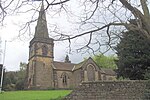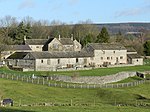River Lathkill
Derwent (Derbyshire) catchmentRivers and valleys of the Peak DistrictRivers of DerbyshireSites of Special Scientific Interest in DerbyshireUse British English from September 2017

The River Lathkill is a river in the Peak District National Park in Derbyshire, England. First recorded in 1280, the name "Lathkill" possibly has Scandinavian roots, the old Norse hlada-kill translating as "narrow valley with a barn".
Excerpt from the Wikipedia article River Lathkill (License: CC BY-SA 3.0, Authors, Images).River Lathkill
A6, Derbyshire Dales
Geographical coordinates (GPS) Address Nearby Places Show on map
Geographical coordinates (GPS)
| Latitude | Longitude |
|---|---|
| N 53.1887 ° | E -1.6392 ° |
Address
A6
DE45 1LB Derbyshire Dales
England, United Kingdom
Open on Google Maps









